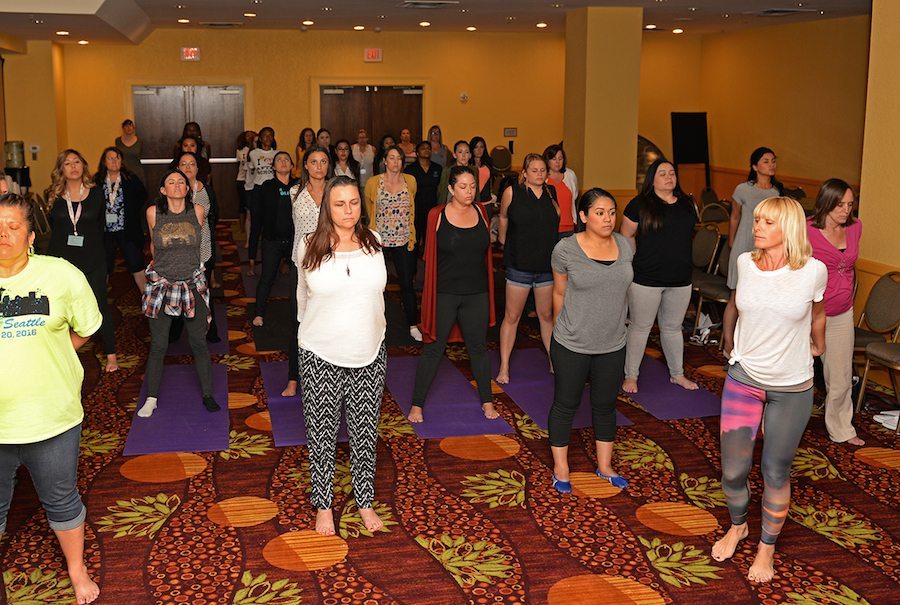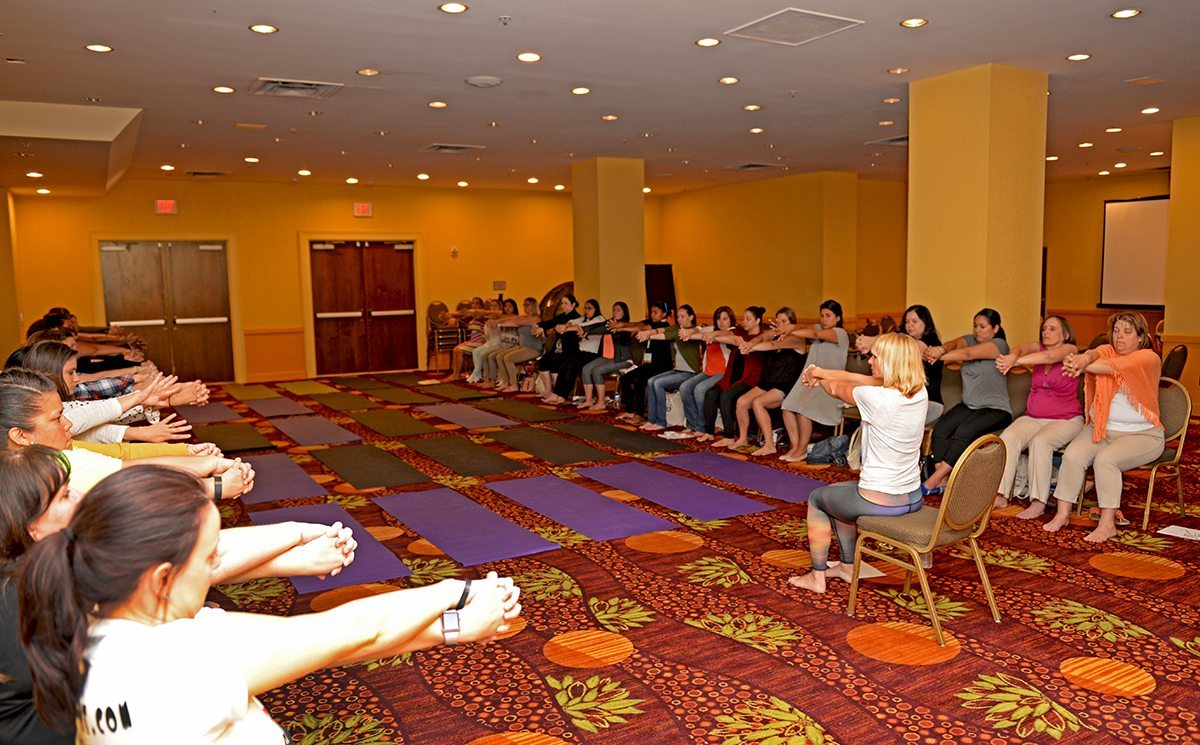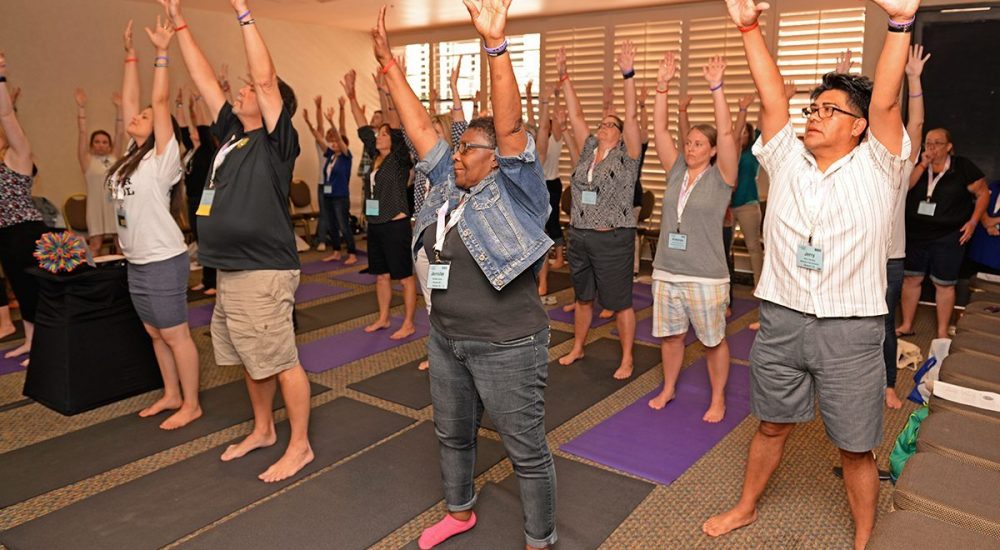The impact of yoga and mindfulness for children has become a topic of research and discussion.
The findings in many studies are that yoga supports children with focus, concentration, self-regulation, and coping with stress. Children and adolescents are faced with more stressors than ever before such as the pressures of standardized tests, social relationships and peer pressures, less time for physical activity, more time in front of technology devices (which can agitate the nervous system), and an overwhelming amount of sensory stimulus in the world around them.
Yoga is being incorporated into school and after school programming for children in order to create a calmer and more peaceful environment for learning. While there is no question that the practice of mindfulness for children has great benefits, what about the educators who work with children in school and after school settings?
Educators face the pressures of standardized testing, compliance with Common Core standards, managing children with challenging behaviors without the proper training and support, limited staffing, high expectations from parents and/or administrations, and overwhelming amounts of paperwork.
Often times educators have a tremendous amount of dedication and commitment to the children they work with but become burnt out from high levels of stress, little recognition for their tireless efforts, and a feeling of being overwhelmed with the many challenges and frustrations they face as educators.
What happens to educators when they become overstressed and how does that impact the children they work with?
The impacts of stress not only affect our physiological state but they also impact our mood, behavior, and overall functioning in life.

Photo credit: Tim Hardy
When we are in a constant state of stress we can develop health issues that include digestive disorders, autoimmune conditions, heart conditions, or a general sense of a lack of well-being. We can become agitated, angry frustrated, depressed or anxious, and may be triggered more easily.
Often times high levels of stress can lead to more impulsive or destructive behaviors such as over-eating, drinking, isolating from others, developing unhealthy relationships, inconsistent sleep patterns, and a lack of self-care.
In order to teach healthy minded children, we must have healthy minded teachers. As educators we create the space for our students. If we are in a stressed or agitated state, this is the energy we bring to our students and this is the overall tone we set for our classroom or program environment.
In reality, we have very little control over the “system” in which we work, and more often than not we may not be able to change the people or circumstance we are in. But, we can change the way in which we react to the stressors in our lives.
Here are 5 Stress Management Techniques for Educators to bring more peace and calm to themselves and the students they work with.
1. Begin and end the day with the mantra – “I am grateful for”

Photo credit: Tim Hardy
We can often get caught up in all of the injustices of our life or the things that are going wrong and causing frustration. When we remind ourselves of what we have to be grateful for, it shifts our attention from what is lacking to what we have to be thankful for. Even the smallest statement of gratitude can shift the energy from negative to positive.
Practice this mantra as you are driving to work and before bed each day. There is always something to be grateful for!
Celebrating even the smallest accomplishments of your students or the children you work with can be a reminder to you of just how important the work you do is.
2. Check in with your BODY and focus your attention on your BREATHING
When we become stressed we tend to move into more chest breathing, which can escalate the sympathetic response or fight/flight/freeze response. Although we do not have control over circumstances in life, we can control our breath. When you start to feel a sense of agitation or anxiety, check in with the sensations in your body, then take 3 deep breaths, in through the nose and out through the nose (or out through the mouth if that is more accessible). When you breathe in, feel a sense of expansion in the diaphragm and the areas of your body where you feel tension. When you exhale, release the tension with your breath.
3. “Check In” and Do a simple Yoga Pose
Doing yoga does not mean that you have to take an hour to go to a yoga class. One or two poses a day can keep us in tune to the tensions in our bodies. When we become stressed, our bodies are often the first to respond by tensing or holding stress in certain areas of the body. Often, due to a combination of stress and poor physical posture from working at a computer or sitting at a desk, many educators experience back pain, neck and shoulder pain, and/or tension headaches. Here is a simple yoga pose that can help alleviate tension in the body, release stress, and soothe the nervous system.
Seated forward bend:
- Sit on the edge of your chair in front of a table or desk.
- Make sure your feet have contact with the floor and your knees are at a 90-degree angle (if not, place a book underneath your feet).
- Lengthen your spine as you lean forward and place your head on your desk/table (a folded hand towel under the forehead is suggested).
- Make sure the back of your neck is long. Bring awareness to the space between your shoulder blades and breathe your breath deeply into the backside of your body, between your shoulder blades (breathe in through nose and out through nose or mouth if that is more accessible).
- With the inhalation, think of expansion and with the exhalation, release tension and worry with the breath.
- Stay here for at least 5 breaths.
4. Take your breaks!

Photo credit: Tim Hardy
Each system is different in terms of how many breaks you are allotted in a day, and for how long, but the reality is that often educators choose to work through their breaks, including their lunch breaks. The reasoning often being, “I have too much work to do.” The truth is, no one is going to tell you to take your breaks, so it is in your hands to take that time to reset.
Leave your classroom or program environment and have your lunch outside or in another space away from your “work space.” These moments of “resetting” are crucial to the restoration of the body and the nervous system. Taking a break away from your workspace for lunch or snacks also supports a more mindful experience with eating which supports healthier digestion.
5. Ground Yourself
This may sound funny, but it can be quite effective in reducing stress. Make a commitment to set aside 5 minutes a day to take your shoes off and stand in the grass or on the earth barefoot. There is a reason why we call the earth the ground and why we use the word “grounded” to describe a feeling. Anxiety and stress is what we call Vata energy. Vata energy has an airy quality, which is in constant motion. By taking our shoes off and connecting to the earth, it creates a greater sense of grounding, provides proprioceptive feedback to the nervous system, and literally “roots” us and offers a more stable and grounded sense of being.
Try to make these activities an integral part of your day, and practice them daily. It takes time to establish a routine but continual practice will eventually make your routine a habit. Notice how you are feeling before starting your routine and check in with yourself a week later to see if there is a difference in your mood and energy.
Then notice if this daily routine has affected your interactions with the kids you work with, or others in your work environment. Notice if this calmer, less stressed version of you has a more calming effect on the children around you. Better yet – teach your students or the children you work with some calming activities and practice them together! You’ll be amazed what a difference it makes!
For breakfast I had an Acai bowl with fresh strawberries, blueberries, gluten-free granola, and shredded coconut!
Author: @yogabyshawnee
This post originally appeared on the Breakfast Club Blog on September 20, 2016.
